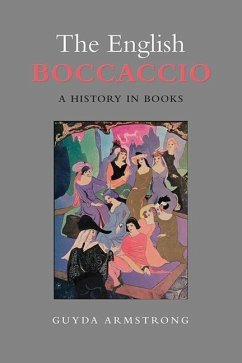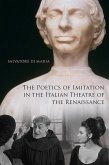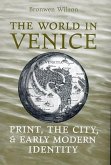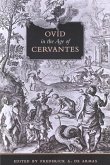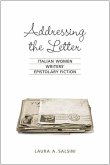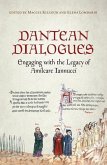89,95 €
89,95 €
inkl. MwSt.
Sofort per Download lieferbar

0 °P sammeln
89,95 €
Als Download kaufen

89,95 €
inkl. MwSt.
Sofort per Download lieferbar

0 °P sammeln
Jetzt verschenken
Alle Infos zum eBook verschenken
89,95 €
inkl. MwSt.
Sofort per Download lieferbar
Alle Infos zum eBook verschenken

0 °P sammeln
- Format: PDF
- Merkliste
- Auf die Merkliste
- Bewerten Bewerten
- Teilen
- Produkt teilen
- Produkterinnerung
- Produkterinnerung

Bitte loggen Sie sich zunächst in Ihr Kundenkonto ein oder registrieren Sie sich bei
bücher.de, um das eBook-Abo tolino select nutzen zu können.
Hier können Sie sich einloggen
Hier können Sie sich einloggen
Sie sind bereits eingeloggt. Klicken Sie auf 2. tolino select Abo, um fortzufahren.

Bitte loggen Sie sich zunächst in Ihr Kundenkonto ein oder registrieren Sie sich bei bücher.de, um das eBook-Abo tolino select nutzen zu können.
Drawing on the disciplines of book history, translation studies, comparative literature, and visual studies, the author focuses on the book as an object, examining how specific copies of manuscripts and printed books were presented to an English readership by a variety of translators.
ArmstrongGuyda:
Guyda Armstrong is a senior lecturer in Italian in the School of Arts, Languages, and Cultures at the University of Manchester.
- Geräte: PC
- ohne Kopierschutz
- eBook Hilfe
- Größe: 3.13MB
- FamilySharing(5)
Andere Kunden interessierten sich auch für
![The Poetics of Imitation in the Italian Theatre of the Renaissance (eBook, PDF) The Poetics of Imitation in the Italian Theatre of the Renaissance (eBook, PDF)]() Salvatore Di MariaThe Poetics of Imitation in the Italian Theatre of the Renaissance (eBook, PDF)66,95 €
Salvatore Di MariaThe Poetics of Imitation in the Italian Theatre of the Renaissance (eBook, PDF)66,95 €![The World in Venice (eBook, PDF) The World in Venice (eBook, PDF)]() Bronwen WilsonThe World in Venice (eBook, PDF)95,95 €
Bronwen WilsonThe World in Venice (eBook, PDF)95,95 €![Corporeal Bonds (eBook, PDF) Corporeal Bonds (eBook, PDF)]() Patrizia SambucoCorporeal Bonds (eBook, PDF)64,95 €
Patrizia SambucoCorporeal Bonds (eBook, PDF)64,95 €![Ovid in the Age of Cervantes (eBook, PDF) Ovid in the Age of Cervantes (eBook, PDF)]() Frederick A. De ArmasOvid in the Age of Cervantes (eBook, PDF)75,95 €
Frederick A. De ArmasOvid in the Age of Cervantes (eBook, PDF)75,95 €![Addressing the Letter (eBook, PDF) Addressing the Letter (eBook, PDF)]() Laura SalsiniAddressing the Letter (eBook, PDF)64,95 €
Laura SalsiniAddressing the Letter (eBook, PDF)64,95 €![Dantean Dialogues (eBook, PDF) Dantean Dialogues (eBook, PDF)]() Dantean Dialogues (eBook, PDF)74,95 €
Dantean Dialogues (eBook, PDF)74,95 €![Dante's Journey to Polyphony (eBook, PDF) Dante's Journey to Polyphony (eBook, PDF)]() Francesco CiabattoniDante's Journey to Polyphony (eBook, PDF)64,95 €
Francesco CiabattoniDante's Journey to Polyphony (eBook, PDF)64,95 €-
-
-
Drawing on the disciplines of book history, translation studies, comparative literature, and visual studies, the author focuses on the book as an object, examining how specific copies of manuscripts and printed books were presented to an English readership by a variety of translators.
ArmstrongGuyda:
Guyda Armstrong is a senior lecturer in Italian in the School of Arts, Languages, and Cultures at the University of Manchester.
ArmstrongGuyda:
Guyda Armstrong is a senior lecturer in Italian in the School of Arts, Languages, and Cultures at the University of Manchester.
Dieser Download kann aus rechtlichen Gründen nur mit Rechnungsadresse in A, B, BG, CY, CZ, D, DK, EW, E, FIN, F, GR, HR, H, IRL, I, LT, L, LR, M, NL, PL, P, R, S, SLO, SK ausgeliefert werden.
Produktdetails
- Produktdetails
- Verlag: University of Toronto Press
- Seitenzahl: 496
- Erscheinungstermin: 30. Oktober 2013
- Englisch
- ISBN-13: 9781442664234
- Artikelnr.: 48945489
- Verlag: University of Toronto Press
- Seitenzahl: 496
- Erscheinungstermin: 30. Oktober 2013
- Englisch
- ISBN-13: 9781442664234
- Artikelnr.: 48945489
- Herstellerkennzeichnung Die Herstellerinformationen sind derzeit nicht verfügbar.
Guyda Armstrong is a senior lecturer in Italian in the School of Arts, Languages, and Cultures at the University of Manchester.
Acknowledgments
Abbreviations
Note on Translation and Transcription
Introduction
1. “Here begynneth the book callyd J. Bochas”: The De casibus virorum
illustrium between Italy and England
2. The Production Context of Boccaccio’s De casibus virorum illustrium
(1360–1373)
3. Form and Functions of the De casibus’s Internal Structures
4. The Production Context of Laurent de Premierfait’s Des cas des nobles
hommes et femmes (1400–1409)
5. The Production Context of John Lydgate’s Fall of Princes (1431–1439)
6. Conclusion
1. The De mulieribus claris in English Translation, 1440–1550 00
2. The Production Context of Boccaccio’s De mulieribus claris (1361–1375)
3. The Middle English Translation of the De mulieribus claris (c. 1440–1460)
4. Henry Parker, Lord Morley’s Of the Ryghte Renoumyde Ladies (c. 1543)
5. Conclusion
6. Boccaccio in Print in the Sixteenth Century
7. European Romance and the French Sending Culture
8. The 1560s: Pleasant Reading (The Palace of Pleasure and A Pleasaunt Disport
of Diuers Noble Personages)
9. The 1580s: Amorous Fiammetta
10. The 1590s: A Famous Tragicall Discourse of Two Lovers, Affrican and Mensola
11. Conclusion
12. “One Hundred Ingenious Novels”: Refashioning the Decameron, 1620–1930
13. The Seventeenth Century: The Translatio Princeps
14. The Eighteenth Century: Excision and Restoration
15. The Nineteenth Century: Through the Peephole
16. Establishing Canonicity: Dubois’s 1804 Edition
17. The 1820s: Griffin’s Serial Decameron and Sharp’s Decameron
18. Mid-century Editions and Popular Readerships: Daly, Bohn, and Blanchard
19. A Limited Licentiousness: John Payne’s Translation
20. The 1890s: Eroticism and Display
21. The Twentieth Century: A Multitude of Decamerons
22. The Decameron in 1930
23. Conclusion
24. The Minor Works in the Nineteenth Century: Dante and Chaucer
25. Neo-medievalism, Dante, and Chaucer
26. Boccaccio and the Academy: The Case of the Trattatello
27. Conclusion
28. The Early Twentieth-Century Recovery of the Minor Works
29. The Author as Lover: The 1907 Fiammetta
30. The Latin Boccaccio Rediscovered: Olympia and the Genealogia
31. Two American Filostratos of the 1920s
32. The Republication of the Historic English Translations
33. The Fall of Princes
34. The De mulieribus claris
35. The Fiammetta
36. The Thirteen Questions
37. Conclusion
Conclusion
Bibliography
Index
Abbreviations
Note on Translation and Transcription
Introduction
1. “Here begynneth the book callyd J. Bochas”: The De casibus virorum
illustrium between Italy and England
2. The Production Context of Boccaccio’s De casibus virorum illustrium
(1360–1373)
3. Form and Functions of the De casibus’s Internal Structures
4. The Production Context of Laurent de Premierfait’s Des cas des nobles
hommes et femmes (1400–1409)
5. The Production Context of John Lydgate’s Fall of Princes (1431–1439)
6. Conclusion
1. The De mulieribus claris in English Translation, 1440–1550 00
2. The Production Context of Boccaccio’s De mulieribus claris (1361–1375)
3. The Middle English Translation of the De mulieribus claris (c. 1440–1460)
4. Henry Parker, Lord Morley’s Of the Ryghte Renoumyde Ladies (c. 1543)
5. Conclusion
6. Boccaccio in Print in the Sixteenth Century
7. European Romance and the French Sending Culture
8. The 1560s: Pleasant Reading (The Palace of Pleasure and A Pleasaunt Disport
of Diuers Noble Personages)
9. The 1580s: Amorous Fiammetta
10. The 1590s: A Famous Tragicall Discourse of Two Lovers, Affrican and Mensola
11. Conclusion
12. “One Hundred Ingenious Novels”: Refashioning the Decameron, 1620–1930
13. The Seventeenth Century: The Translatio Princeps
14. The Eighteenth Century: Excision and Restoration
15. The Nineteenth Century: Through the Peephole
16. Establishing Canonicity: Dubois’s 1804 Edition
17. The 1820s: Griffin’s Serial Decameron and Sharp’s Decameron
18. Mid-century Editions and Popular Readerships: Daly, Bohn, and Blanchard
19. A Limited Licentiousness: John Payne’s Translation
20. The 1890s: Eroticism and Display
21. The Twentieth Century: A Multitude of Decamerons
22. The Decameron in 1930
23. Conclusion
24. The Minor Works in the Nineteenth Century: Dante and Chaucer
25. Neo-medievalism, Dante, and Chaucer
26. Boccaccio and the Academy: The Case of the Trattatello
27. Conclusion
28. The Early Twentieth-Century Recovery of the Minor Works
29. The Author as Lover: The 1907 Fiammetta
30. The Latin Boccaccio Rediscovered: Olympia and the Genealogia
31. Two American Filostratos of the 1920s
32. The Republication of the Historic English Translations
33. The Fall of Princes
34. The De mulieribus claris
35. The Fiammetta
36. The Thirteen Questions
37. Conclusion
Conclusion
Bibliography
Index
Acknowledgments
Abbreviations
Note on Translation and Transcription
Introduction
1. “Here begynneth the book callyd J. Bochas”: The De casibus virorum
illustrium between Italy and England
2. The Production Context of Boccaccio’s De casibus virorum illustrium
(1360–1373)
3. Form and Functions of the De casibus’s Internal Structures
4. The Production Context of Laurent de Premierfait’s Des cas des nobles
hommes et femmes (1400–1409)
5. The Production Context of John Lydgate’s Fall of Princes (1431–1439)
6. Conclusion
1. The De mulieribus claris in English Translation, 1440–1550 00
2. The Production Context of Boccaccio’s De mulieribus claris (1361–1375)
3. The Middle English Translation of the De mulieribus claris (c. 1440–1460)
4. Henry Parker, Lord Morley’s Of the Ryghte Renoumyde Ladies (c. 1543)
5. Conclusion
6. Boccaccio in Print in the Sixteenth Century
7. European Romance and the French Sending Culture
8. The 1560s: Pleasant Reading (The Palace of Pleasure and A Pleasaunt Disport
of Diuers Noble Personages)
9. The 1580s: Amorous Fiammetta
10. The 1590s: A Famous Tragicall Discourse of Two Lovers, Affrican and Mensola
11. Conclusion
12. “One Hundred Ingenious Novels”: Refashioning the Decameron, 1620–1930
13. The Seventeenth Century: The Translatio Princeps
14. The Eighteenth Century: Excision and Restoration
15. The Nineteenth Century: Through the Peephole
16. Establishing Canonicity: Dubois’s 1804 Edition
17. The 1820s: Griffin’s Serial Decameron and Sharp’s Decameron
18. Mid-century Editions and Popular Readerships: Daly, Bohn, and Blanchard
19. A Limited Licentiousness: John Payne’s Translation
20. The 1890s: Eroticism and Display
21. The Twentieth Century: A Multitude of Decamerons
22. The Decameron in 1930
23. Conclusion
24. The Minor Works in the Nineteenth Century: Dante and Chaucer
25. Neo-medievalism, Dante, and Chaucer
26. Boccaccio and the Academy: The Case of the Trattatello
27. Conclusion
28. The Early Twentieth-Century Recovery of the Minor Works
29. The Author as Lover: The 1907 Fiammetta
30. The Latin Boccaccio Rediscovered: Olympia and the Genealogia
31. Two American Filostratos of the 1920s
32. The Republication of the Historic English Translations
33. The Fall of Princes
34. The De mulieribus claris
35. The Fiammetta
36. The Thirteen Questions
37. Conclusion
Conclusion
Bibliography
Index
Abbreviations
Note on Translation and Transcription
Introduction
1. “Here begynneth the book callyd J. Bochas”: The De casibus virorum
illustrium between Italy and England
2. The Production Context of Boccaccio’s De casibus virorum illustrium
(1360–1373)
3. Form and Functions of the De casibus’s Internal Structures
4. The Production Context of Laurent de Premierfait’s Des cas des nobles
hommes et femmes (1400–1409)
5. The Production Context of John Lydgate’s Fall of Princes (1431–1439)
6. Conclusion
1. The De mulieribus claris in English Translation, 1440–1550 00
2. The Production Context of Boccaccio’s De mulieribus claris (1361–1375)
3. The Middle English Translation of the De mulieribus claris (c. 1440–1460)
4. Henry Parker, Lord Morley’s Of the Ryghte Renoumyde Ladies (c. 1543)
5. Conclusion
6. Boccaccio in Print in the Sixteenth Century
7. European Romance and the French Sending Culture
8. The 1560s: Pleasant Reading (The Palace of Pleasure and A Pleasaunt Disport
of Diuers Noble Personages)
9. The 1580s: Amorous Fiammetta
10. The 1590s: A Famous Tragicall Discourse of Two Lovers, Affrican and Mensola
11. Conclusion
12. “One Hundred Ingenious Novels”: Refashioning the Decameron, 1620–1930
13. The Seventeenth Century: The Translatio Princeps
14. The Eighteenth Century: Excision and Restoration
15. The Nineteenth Century: Through the Peephole
16. Establishing Canonicity: Dubois’s 1804 Edition
17. The 1820s: Griffin’s Serial Decameron and Sharp’s Decameron
18. Mid-century Editions and Popular Readerships: Daly, Bohn, and Blanchard
19. A Limited Licentiousness: John Payne’s Translation
20. The 1890s: Eroticism and Display
21. The Twentieth Century: A Multitude of Decamerons
22. The Decameron in 1930
23. Conclusion
24. The Minor Works in the Nineteenth Century: Dante and Chaucer
25. Neo-medievalism, Dante, and Chaucer
26. Boccaccio and the Academy: The Case of the Trattatello
27. Conclusion
28. The Early Twentieth-Century Recovery of the Minor Works
29. The Author as Lover: The 1907 Fiammetta
30. The Latin Boccaccio Rediscovered: Olympia and the Genealogia
31. Two American Filostratos of the 1920s
32. The Republication of the Historic English Translations
33. The Fall of Princes
34. The De mulieribus claris
35. The Fiammetta
36. The Thirteen Questions
37. Conclusion
Conclusion
Bibliography
Index
